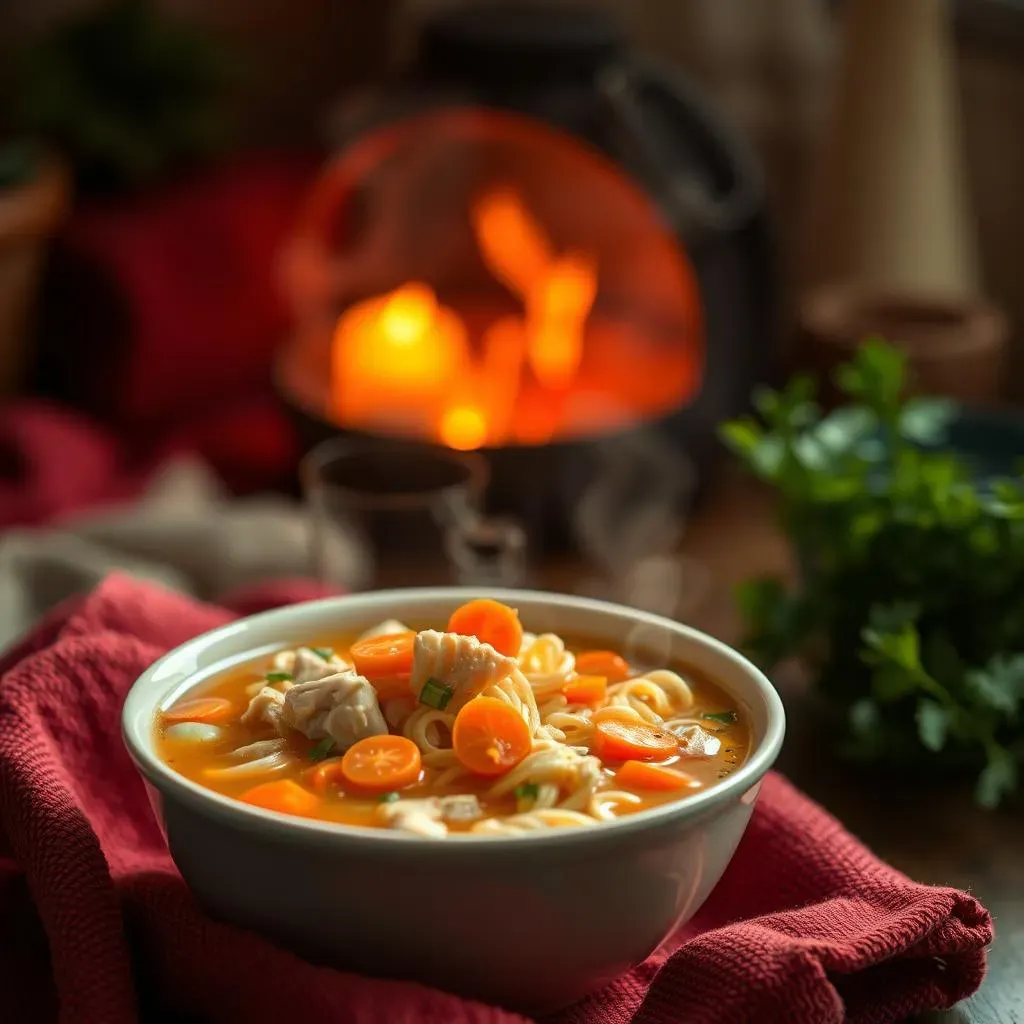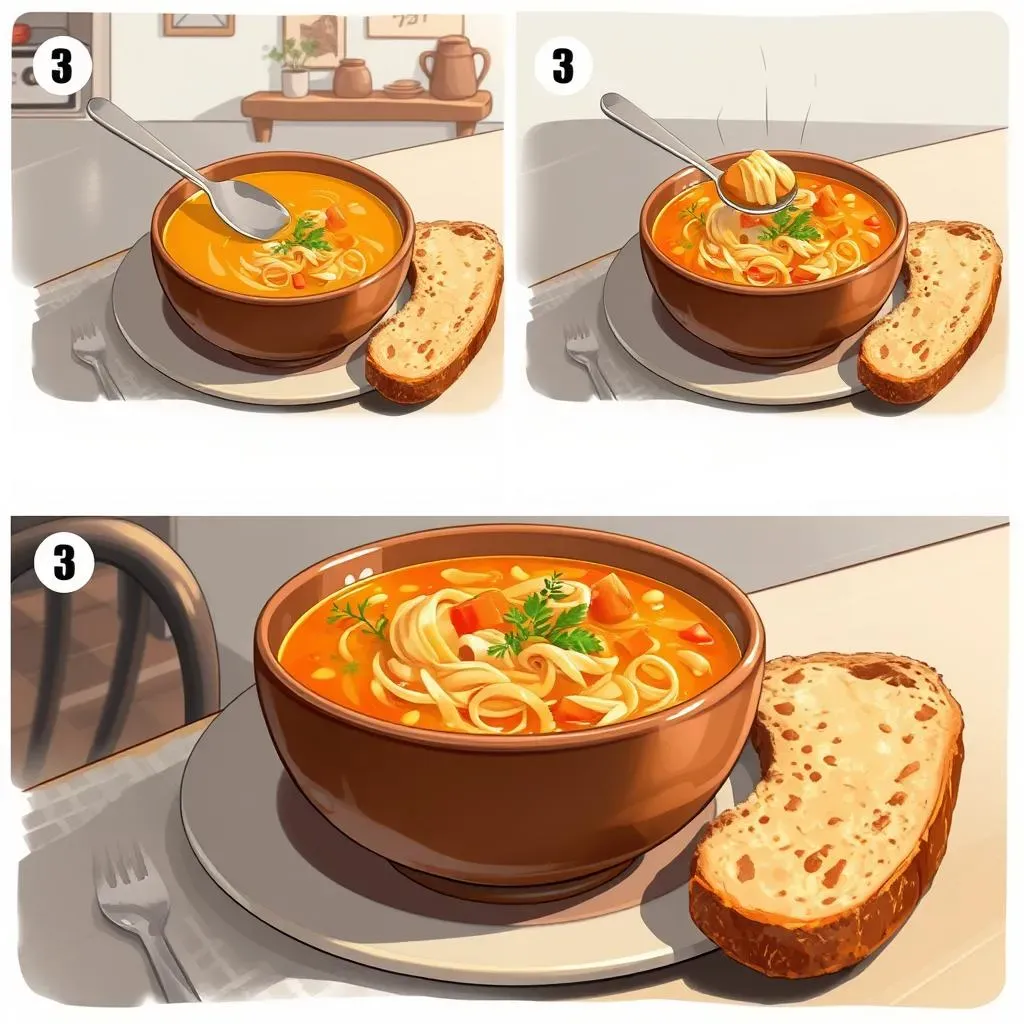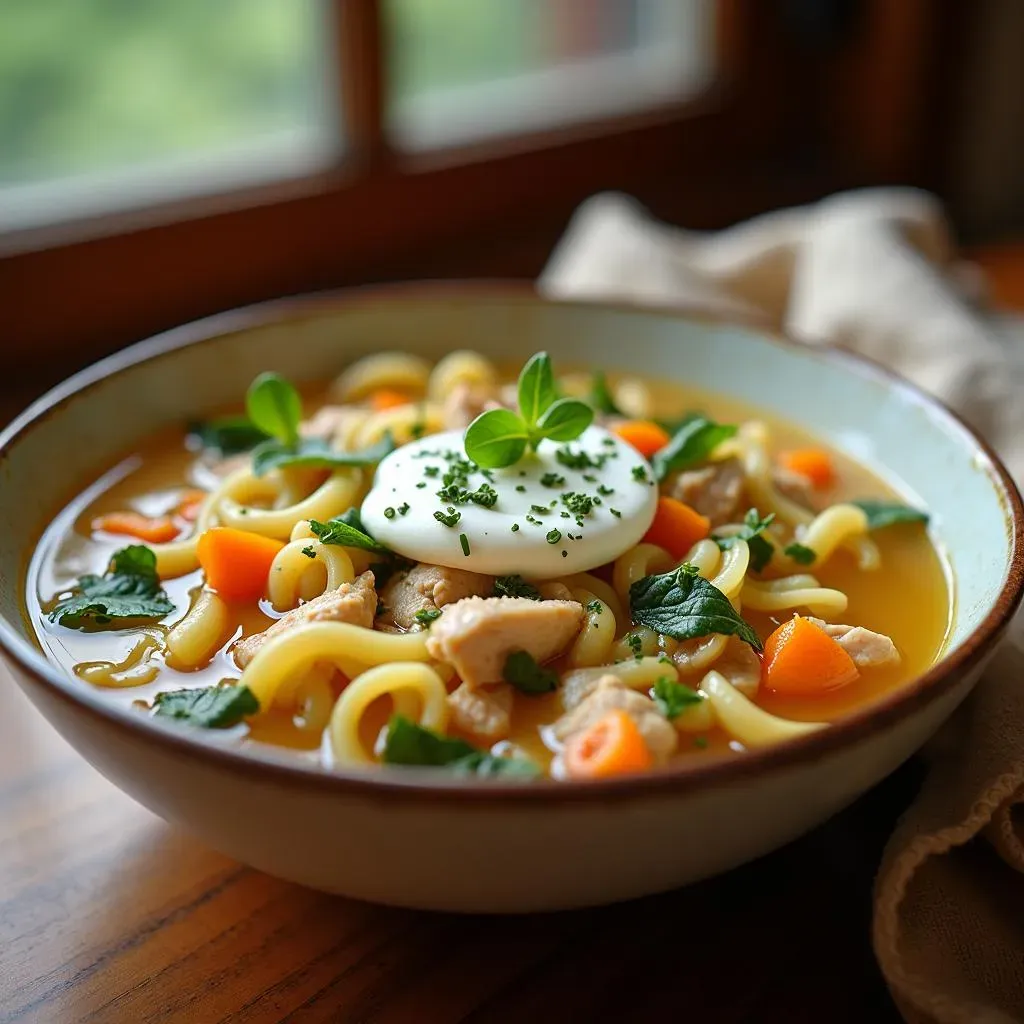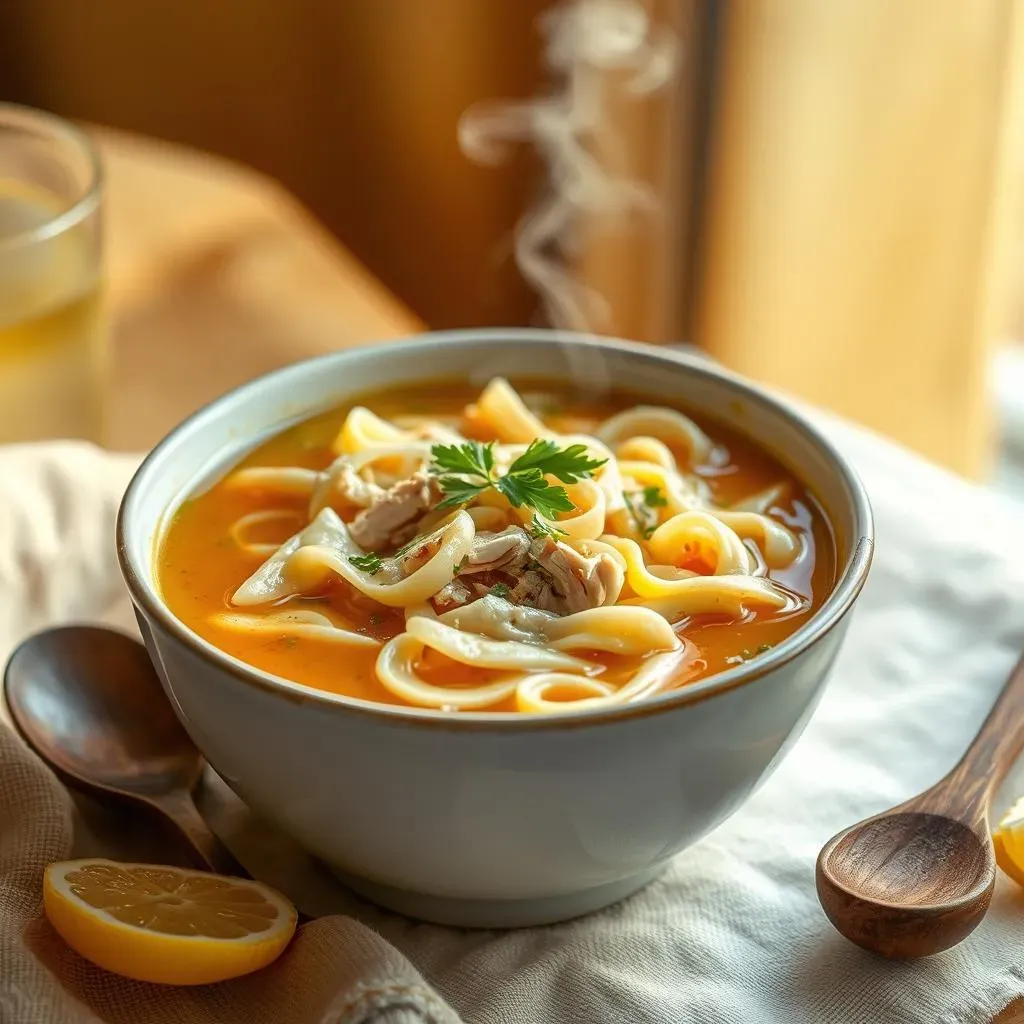Table of Contents
Feeling under the weather? A bowl of warm, comforting chicken noodle soup can be a game-changer. It's not just an old wives' tale; there's real magic in this classic remedy, especially when you're sick. This isn't your average canned soup; we're talking about a homemade chicken noodle soup recipe for sick people that’s packed with nutrients and flavor. Forget those bland, watery versions. We're going to walk you through creating a soup that will soothe your throat, clear your sinuses, and nourish your body back to health. This article will show you exactly how to whip up this healing elixir, from choosing the right ingredients to mastering the cooking process. We’ll also explore ways to customize your soup for maximum comfort. So, grab your apron, and let’s get cooking!
The Magic of Chicken Noodle Soup for the Sick

The Magic of Chicken Noodle Soup for the Sick
Why Chicken Noodle Soup Works
Okay, so you're sniffling, sneezing, and feeling generally blah. What's the first thing that pops into your head? For me, it's always chicken noodle soup. It's like a warm hug in a bowl, right? But it's not just about comfort; there's some real science behind why it makes you feel better when you're sick. The warmth of the broth helps to soothe a sore throat and the steam can help clear up congestion. It's basically a natural decongestant, and who doesn't need that when you're all stuffed up?
Plus, the broth is super hydrating. When you're sick, you often don't feel like drinking much, but keeping hydrated is key for recovery. Chicken noodle soup sneaks in that hydration without you even really thinking about it. It's like a stealthy superhero fighting off the sickness. And let's not forget about the nutrients packed into it. Chicken provides protein, veggies add vitamins, and the noodles give you a little energy boost. It's a powerhouse of good stuff when you need it most.
The Science Behind the Soup
So, why does this particular soup work so well? Well, it's all about the ingredients working together. The chicken itself contains an amino acid called cysteine, which is released when the chicken simmers in the broth. This cysteine is similar to a medication called acetylcysteine, which is used to thin mucus. That's why your sinuses feel a little clearer after eating soup. And the warm liquid helps to loosen up that congestion, making it easier to breathe.
On top of that, the anti-inflammatory properties of certain veggies, like carrots and celery, can help to reduce inflammation and soothe your body. It's like a gentle, natural way to calm everything down. It's not a cure-all, but it certainly helps your body fight off those nasty germs. It's like giving your immune system a little army of helpful ingredients, all working together to get you back on your feet.
Ingredient | Benefit |
|---|---|
Chicken | Provides cysteine (thins mucus), protein |
Broth | Hydrates, soothes sore throat |
Carrots & Celery | Anti-inflammatory properties |
Noodles | Provides energy |
A Comforting Tradition
Beyond the science, there's a huge comfort factor associated with chicken noodle soup. It’s something many of us grew up with, a dish that our parents or grandparents made when we weren't feeling well. That familiarity and those memories can have a powerful effect on our emotional state when we're sick. It’s like a little piece of home, a reminder that someone cares. And when you're feeling awful, that emotional comfort is as important as the physical benefits. So yeah, chicken noodle soup, it's more than just a meal; it's a tradition, a remedy, and a warm hug all rolled into one.
Essential Ingredients for a Healing Chicken Noodle Soup Recipe

Essential Ingredients for a Healing Chicken Noodle Soup Recipe
The Broth Base: Liquid Gold
Alright, let’s talk broth. This isn’t just water; it's the soul of your chicken noodle soup recipe for sick people. You've got a couple of choices here, and each brings something different to the party. First up, there's chicken broth, which is great for a classic flavor. It’s easy to find in any grocery store and provides a solid foundation for the soup. Then, there's homemade chicken stock, which takes things to another level. Making your own stock allows you to control the flavor and pack in even more nutrients. You can simmer chicken bones with veggies for hours, extracting all the good stuff. Trust me, it’s worth the effort if you have the time. It's like giving your soup a supercharge of flavor and healing power.
If you’re short on time, don’t sweat it. A good quality store-bought broth will still do the trick. Just make sure to look for low-sodium options to control the salt content. And if you're feeling fancy, you could even mix a bit of bone broth into your chicken broth for an extra boost of collagen. The key is to have a rich and flavorful base that will carry all the other ingredients. It’s the canvas for your masterpiece, so choose wisely.
The Power of Protein and Veggies
Next up, the stars of the show: chicken and veggies. For chicken, you can use bone-in, skin-on pieces for maximum flavor and benefits. The bones release collagen into the broth, which is great for joint health, and the skin adds extra richness. If you prefer boneless, skinless chicken breasts, that's okay too. Just make sure to shred or cube it before adding it to the soup. The chicken provides the protein you need to help your body rebuild and recover. It’s like the construction crew getting things back in shape.
Then, we've got our veggie crew. The classics are carrots, celery, and onions. Carrots are packed with vitamin A, which is great for your immune system. Celery adds a nice crunch and has anti-inflammatory properties, and onions bring that savory flavor that ties everything together. You can also add other veggies like garlic, which has antimicrobial properties, or some ginger, which can help to soothe an upset stomach. It’s like adding your own personal army of vitamins and minerals to fight off the sickness. The more the merrier, I say!
Ingredient | Benefit |
|---|---|
Bone-in Chicken | Collagen, rich flavor |
Carrots | Vitamin A, immune boost |
Celery | Anti-inflammatory |
Onions | Savory flavor |
Noodles and Seasoning: The Finishing Touches
Now, let's talk noodles. You can use classic egg noodles, which are pretty standard for chicken noodle soup. They are soft and comforting, perfect for when you're not feeling well. But honestly, any kind of noodle will do. You could use small pasta shapes like ditalini or orzo, or even gluten-free alternatives if you have dietary restrictions. The key is to choose something that you enjoy and that’s easy to eat. The noodles are like the comforting blanket that wraps everything up, making the soup more satisfying.
Finally, seasonings. Don't underestimate the power of herbs and spices. Salt and pepper are essential, but you can also add a little fresh thyme, parsley, or dill. These herbs not only enhance the flavor but also have some health benefits. A bay leaf or two can add extra depth to the broth. Remember, it's all about building layers of flavor. It’s like adding the final touches to your masterpiece, making it perfect and complete. Don't be afraid to experiment with different herbs and spices until you find what you love.
StepbyStep: Making the Perfect Chicken Noodle Soup When Sick

StepbyStep: Making the Perfect Chicken Noodle Soup When Sick
Getting Started: The Prep Work
Alright, let's get cooking! First things first, gather all your ingredients. It's like getting your tools ready before starting a big project. Chop your veggies – carrots, celery, and onions – into bite-sized pieces. You don't want them too big, especially if your throat is sore. If you're using bone-in chicken, give it a rinse under cold water. If you're using boneless chicken, you can shred or cube it now, or wait until it's cooked. I like to have everything ready to go before I even turn on the stove. It makes the whole process so much smoother. It's like having your mise en place ready for a cooking show.
Next, grab a big pot. A Dutch oven works great, but any large pot will do. It needs to be big enough to hold all the ingredients and broth. Pour in a little olive oil or butter and heat it over medium heat. Once the oil is hot, add your chopped onions and cook them until they start to soften and become translucent. This usually takes about 3-5 minutes. Then toss in your carrots and celery and cook for another 3-5 minutes. This step is important because it builds the base flavor of your soup. It's like setting the stage for the rest of the ingredients to shine.
Step | Action |
|---|---|
1 | Gather ingredients, chop veggies |
2 | Heat oil in pot, add onions |
3 | Add carrots and celery, cook until softened |
Simmering to Perfection: The Cooking Process
Now that your veggies are softened, it’s time to add the chicken. If you’re using bone-in pieces, place them directly into the pot. If you’re using boneless chicken, toss it in now. Next, pour in your chicken broth or stock. Make sure there’s enough liquid to cover all the ingredients. Bring the soup to a gentle boil, then reduce the heat to low, cover the pot, and let it simmer. This slow simmering process is where the magic happens. It allows all the flavors to meld together and the chicken to become tender. It’s like a slow dance of flavors, getting to know each other.
While the soup is simmering, you can add your seasonings. Salt, pepper, thyme, parsley, bay leaf, whatever you like. You can also add a little garlic for an extra boost of flavor. I like to let the soup simmer for at least 30 minutes, but the longer it simmers, the better it tastes. If you're using bone-in chicken, remove it from the pot after about 30 minutes, shred the meat, and then add it back to the pot. About 15 minutes before you’re ready to eat, add in your noodles. Cook them according to the package directions. It’s like adding the final piece to the puzzle, bringing everything together.
Customizing Your Chicken Noodle Soup Recipe for Extra Comfort

Customizing Your Chicken Noodle Soup Recipe for Extra Comfort
Adding a Kick: Spice It Up
Sometimes, when you're feeling really under the weather, you need a little extra oomph in your soup. That's where spices come in! A pinch of red pepper flakes can add a nice bit of heat to help clear up your sinuses. If you're a fan of ginger, adding some fresh or ground ginger can help to soothe an upset stomach and reduce inflammation. Turmeric is another great option. It has powerful anti-inflammatory properties and gives the soup a beautiful golden color. It's like giving your soup a little boost of superpowers. Just remember to start with a small amount and add more to taste. You don't want to overdo it and make your soup too spicy, especially when your throat is already sore.
Spice | Benefit |
|---|---|
Red Pepper Flakes | Clears sinuses, adds heat |
Ginger | Soothes stomach, reduces inflammation |
Turmeric | Anti-inflammatory, adds color |
Extra Veggies and Add-Ins
Don't be afraid to load up your soup with even more veggies. Spinach, kale, or other leafy greens add extra vitamins and minerals. They wilt down quickly in the hot broth, so you can toss them in at the end. If you’re a mushroom fan, adding sliced mushrooms can give the soup a nice earthy flavor. For an extra dose of comfort, consider adding a touch of lemon juice to the bowl before serving. The lemon brightens up the flavor and can help to soothe a sore throat. It’s like giving your soup a personal touch, making it exactly what you need.
Other add-ins can include a dollop of Greek yogurt for creaminess or a sprinkle of fresh herbs like dill or parsley for added flavor and freshness. If you’re feeling adventurous, you can try adding a touch of miso paste for an umami boost. It’s all about experimenting and finding what you love. The point is to make your soup as comforting and nourishing as possible. It’s like creating your own personalized healing potion, tailored specifically to your needs.
Making it Your Own: Dietary Needs
If you have any dietary restrictions, it's easy to adapt this recipe to fit your needs. For a gluten-free version, simply use gluten-free noodles or skip the noodles altogether and add extra veggies. For a vegetarian or vegan option, you can use vegetable broth instead of chicken broth and add tofu or chickpeas for protein. You can also add beans or lentils for extra fiber. The key is to be creative and make substitutions that work for you. It’s like having a flexible recipe that can be adapted to anyone’s needs.
If you're dealing with a sensitive stomach, it may be best to avoid very strong spices and stick to milder herbs and seasonings. You can also opt for a low-sodium broth to control the salt content. It’s important to listen to your body and make adjustments as needed. The goal is to create a soup that not only tastes good but also helps you feel better. It's like having your own personal chef who knows exactly what your body needs.
Wrapping Up: Your Bowl of Healing
So, there you have it – a simple yet powerful chicken noodle soup recipe designed to help you feel better when you're sick. It's more than just a meal; it's a warm hug in a bowl, packed with goodness and made with love. Remember, the key is to use fresh, quality ingredients and to take your time with the cooking process. Whether you stick to our basic recipe or get creative with your own additions, this soup is sure to bring comfort and aid in your recovery. Don't wait until you're feeling awful to try it; keep this recipe handy for the next time you or a loved one needs a little extra TLC. Happy cooking, and get well soon!
